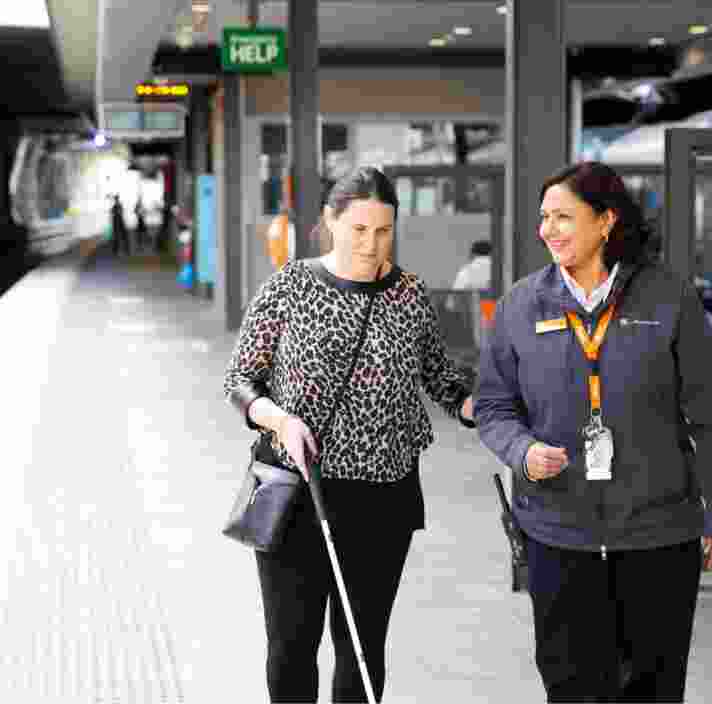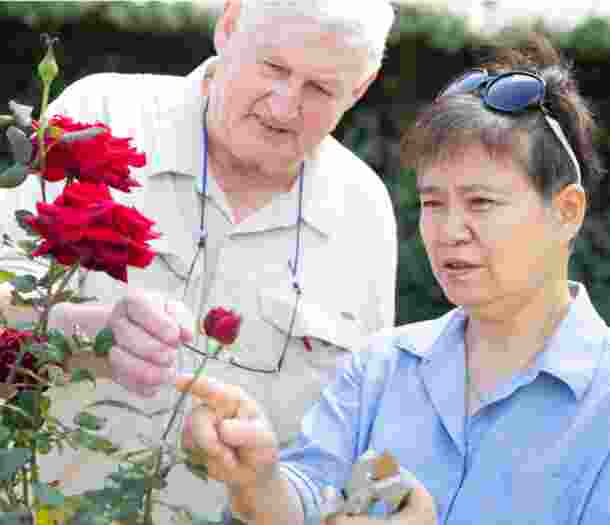Guiding a person with blindness or low vision
Guiding a person.
People with low vision sometimes require assistance to move through certain situations. The aim of providing guidance is to support a person so they can travel safely, confidently and efficiently.
There are a variety of guiding practices that apply to different scenarios. Good communication is the key to being a good guide. Below are some suggestions for guiding. If you’re ever unsure about anything, just ask.

Providing directions
If a person with blindness or low vision needs directions, give them clear and precise directions from where they are located.
It’s often useful (and easier) to stand in the same orientation to the person you are assisting so that your left is the same as their left.
Use indicators such as right or left, compass points or clock-face directions. For example, “the bathroom is located about 5 metres to your left”.
When using the clock face method, give directions from the reference of the person positioned at 6 o’clock, facing 12 o’clock. Directions are then described relative to their location on the clock-face, e.g. “Your drink is at two o’clock on the table”. Don’t point or use vague descriptions such as “over there”.
Always ask the person with blindness or low vision what their preferred method to receive the directions is. Always ask for the best way to assist each individual.
Assisting with orientation
Understanding orientation.
Orientation is the understanding of knowing where you are, where you are going, how to get there and knowing when you have perhaps gone off track.
Providing orientation can help a person to:
- understand the layout of a room or space
- locate personal items
- identify who else is in a room or area
- move around a space independently.
People with blindness or low vision may be unable to see the layout and contents of a room, so ask if you can provide verbal orientation and/or a physical tour of the unfamiliar space.
How to assist.
To assist with orientation you can describe the shape and size of the room. Mention any surface texture changes such as carpet, wooden flooring or tiled surfaces.
You could offer to guide a person around a room or space so that they can feel where things are located. Another technique is to place your hand under the person’s hand and point towards an item or location. If you’re ever unsure, always ask the person with blindness or low vision for the best way to assist them.
Communication
Clear communication is the key when interacting with a person with blindness or low vision.
The following techniques will ensure effective, safe and comfortable interactions. Remember, not every person with blindness or low vision will need this type of assistance. You should always ask for the best way to assist each individual.
- Always introduce yourself and state who you are or your role.
- Always address the person directly and never through a third person (for example, a spouse or carer who may be with them).
- If there are other people in the room, let the person with blindness or low vision know who is in attendance and where they are positioned.
- Always announce yourself on arrival and departure. If you are there to conduct a procedure, (as a nurse, for example) say beforehand what actions you will be performing (for example, taking their observations).
- You will also need to state what is going to happen to the person before and throughout the procedure. For example, “Hi Rosie, it’s Stella your nurse. I’d like to place a probe into your right ear to take your temperature”.

